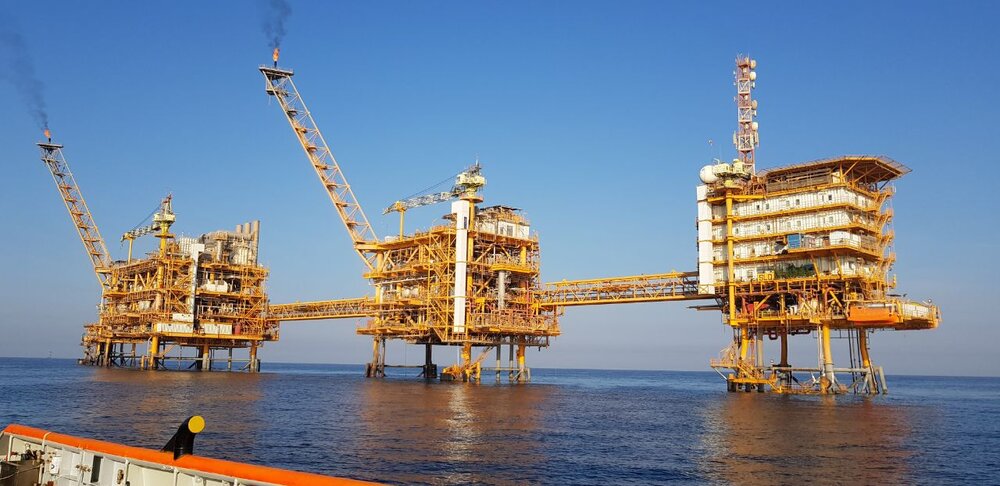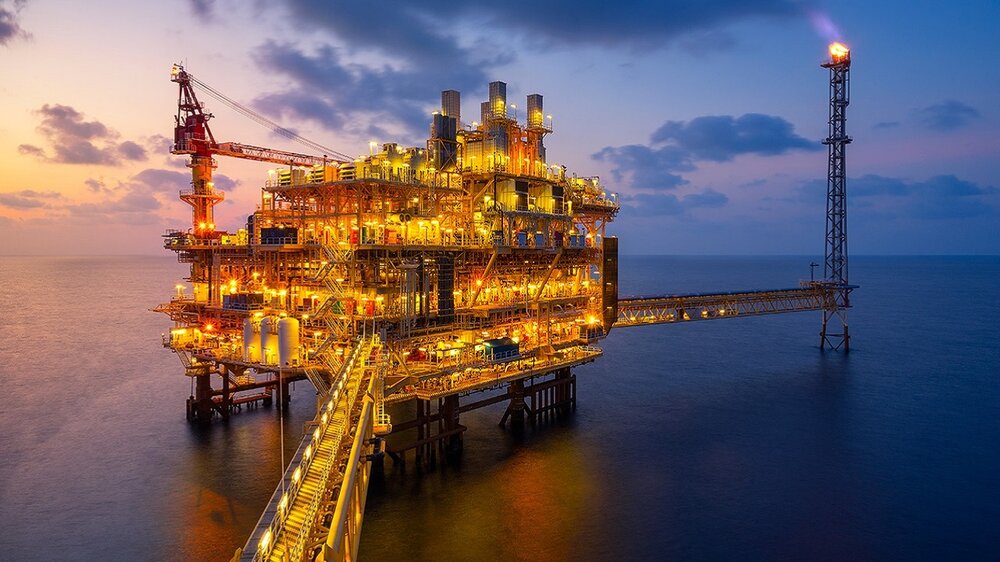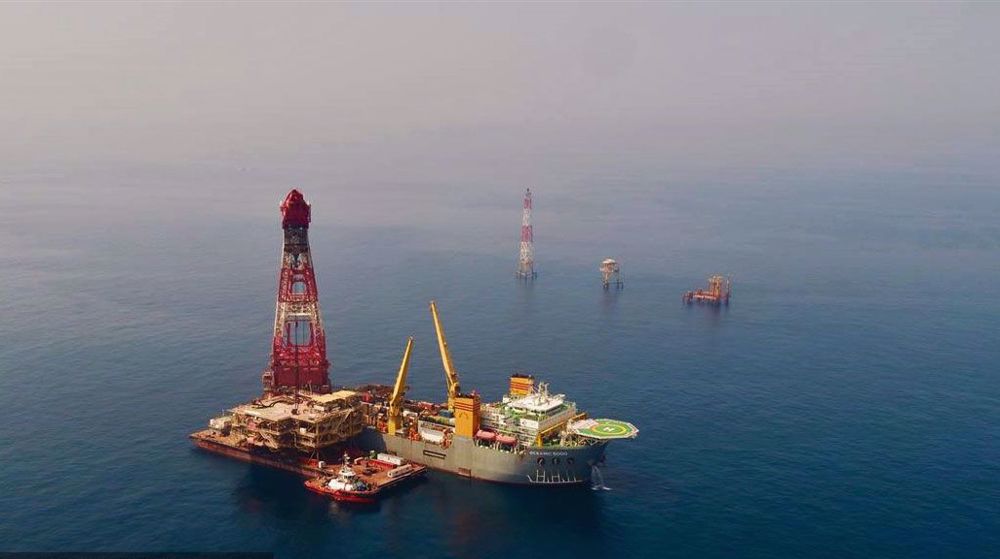Iran (IMNA) - Total had signed a $4.9 billion deal with the National Iranian Oil Company (NIOC) under the former government to produce 2 billion cubic feet per day or 400,000 barrels of oil equivalent per day including condensate, with output due to start in early 2021.
It and other international firms, however, lost the project to Iranian companies, Minister of Petroleum Javad Owji said during the installation of the first offshore platform for Phase 11 of South Pars in the Persian Gulf last week.

The construction, shipment and installation of the gigantic structure capped a feat of well design; production, reservoir, geological and infrastructure engineering and development of surface facilities by Iranian companies.
It was in 2005 when NIOC signed a memorandum of understanding for the upstream development of Phase 11 and the construction of a 10 million-tonne LNG production plant. Petronas later joined the $11.2 billion project in a joint venture, 40 percent held by Total, 50 percent by NIOC and 10 percent by Malaysia’s national oil firm.
In 2008, Total and Petronas announced that high development costs in the wake of rising steel prices had forced them to delay a final decision on investment after Iran had repeatedly extended a deadline. Tehran finally dismissed them from the project which was overshadowed by haggling over contract terms.
The project then was awarded to China National Petroleum Corporation (CNPC) in 2010 on a $4 billion financial plan. According to the contract, CNPC should have brought Phase 11 to production within 52 months, but long delays forced Iran to ditch it in 2012.
After the removal of the Chinese company, Iran decided to carry out the development of the offshore sector independently and earlier than the onshore part because a simultaneous operation in both sections was time-consuming.
Subsequently, an MoU for marine development of the phase was signed between Petropars and Iran Marine Engineering and Construction Company in May 2013 with the aim of building and operating a jacket, two platforms and two lines of submarine pipeline to transfer gas to the onshore refinery.
Later in August 2013, the contract for the development of the field was awarded to Petropars under a buy-back deal in which the developer is repaid for its investment in oil or gas once production begins, plus a fixed rate of return.
According to the contract, Petropars undertook to construct and install two wellhead platforms (base and deck) and drill 12 wells in each platform, besides building two pipelines of 32 inches each with a length of about 135 km to transfer gas to land as well as facilities for receiving, separating and stabilizing condensates plus condensate storage tanks on land and gas condensate export facilities.
No sooner had eight months passed since the signing of the contract than Petropars withdrew from the project, with then minister of petroleum Bijan Zanganeh declaring that Phase 11 was not the priority at the time and that a decision would be made in due course.
Time passed by and the development of Phase 11 got stuck in uncertainty, until in 2015 Total stepped in again and offered to work in South Pars.
The French company finally signed a second contract, with a 20-year duration, in 2017 after Iran had concluded the nuclear agreement with the West. It was the operator of the $5.9 billion project with a 50.1% interest alongside the Chinese state-owned oil and gas company CNPC (30%), and Petropars (19.9%), a wholly owned subsidiary of NIOC.
Total again pulled out of the project in late August 2018 after failing to obtain a waiver from reinstated US sanctions on Tehran. The withdrawal was not unexpected but Iran had to pay with further delays for trusting a side which like other French companies was known for breach of contract.
Phase 11 is the farthest border section of South Pars which Iran shares with Qatar, and every day that is lost costs the country in lost revenue.
CNPC then replaced Total as the operator, but it also suspended investment in fear of US sanctions in December of the same year, leaving Petropars in total control.
The Iranian company started work from October 2018. It had to build two platforms - which normally takes five years to complete one - to produce 56 million cubic meters of gas per day.
With the inauguration of the new government in August 2021, a new initiative was proposed at NIOC under which one of the platforms at Phase 12 whose production was no longer economical would be removed and installed at Phase 11.
Moving the 3,200-tonne platform required strong logistics, for which Iran brought the Oceanic 5000 crane ship from Russian waters and did the job.

Oceanic 5000 is installing the platform for Phase 11 of South Pars in the Persian Gulf.
“The installation of such a heavy structure requires a complex and precise engineering work, all of which was done in the 13th government to produce gas from Phase 11,” Owji said at the installation ceremony on Wednesday.
The phase will now start production at 15 million cubic meters per day and reach an ultimate capacity of 56 million cubic meters of gas, 50,000 barrels of gas condensate and 750 tonnes of sulfur per day when its development is complete.
The construction and installation of the second platform, currently underway, and drilling of new wells at Phase 11 is an important step in Iran’s drive to achieve energy independence and geopolitical stability, which will dramatically increase the gas production capacity at South Pars.
It will meet Iran's domestic consumption needs and help the country emerge as an important regional exporter.
The economic benefits of completing Phase 11 are many. It is estimated to create up to 10,000 jobs and bring $20 billion of income to Iran. In addition, it will help revive Iran's oil and gas sector, which has been struggling over the years due to sanctions and low investment.
The project also captures the fruition of the unique efforts of Iranian companies and specialists who set remarkable records and initiatives in various operational processes, such as removal, transfer and installation of platforms, drilling and building pipelines.
The countdown has now begun for the start of gas production from the phase in a ceremony attended by President Ebrahim Raeisi in the coming weeks -- something Iran’s nuclear agreement with the West and subsequent agreements with international energy companies were not sufficient to fulfill.

Phase 11 will now start production at 15 million cubic meters per day and reach an ultimate capacity of 56 million cubic meters of gas, 50,000 barrels of gas condensate and 750 tonnes of sulfur per day. (Photo by Shana)
“To produce from this phase, we did not wait for the removal of the sanctions and the participation of foreign companies. Now Total and Shell companies are left wondering how we did this within 20 months,” Owji said.
“The Phase 11 development contract with Total and a consortium of foreign companies in the previous government was worth $4.9 billion, but they lost it to Iranian companies because from zero to one hundred of the project was carried out by Iranian experts,” he added.
With Phase 11, the file of production from the last phase of South Pars is now closed, but a new chapter has just begun in Iran’s sprawling petroleum industry which will not have to wait anymore for foreign companies to carry out its projects - and that with so many strings attached and sky-high costs.
Presstv


Your Comment